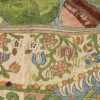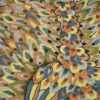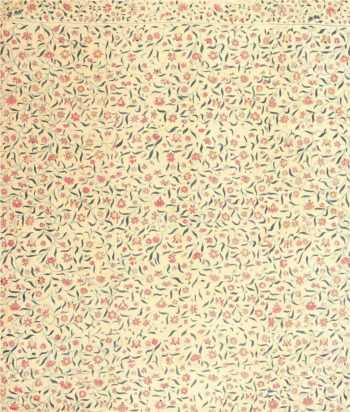Large 17th Century Indo-Portuguese Summer Carpet 46159
Beautifully woven and remarkably well preserved considering its advanced age, this antique Suzani embroidery from 17th Century India is a truly unique and remarkable example of fine antique weaving.
Large 17th Century Indo-Portuguese Summer Carpet, Origin: India, Circa: Late 17th Century – Some pieces are simply too spectacular to adequately describe with words, and this is one of them. This Suzani embroidery is a palace-sized piece of incredible detail. It evokes the feeling of the Garden of Paradise with an impressive variety of plant and animal life. This stunningly detailed piece was created by hand in the late 17th century and is remarkably well-preserved. Suzani is a word that means needle. They were produced throughout central Asian countries and were usually part of a bridal dowry or special political gifts. This one is from India. Its level of preservation supports that it was only brought out and used for special occasions.
The exceptionally fine work requires a fine backing of either cotton or silk. They are embroidered using silk and use only a repertoire of a few different stitches. They use couching, chain, satin, and buttonhole stitches. Silk allows for exceptionally fine threads to be spun, and it also allows for the production of vibrant colors that remain so for centuries. Work of this level of detail probably took many years to complete. Every stitch of this piece was done by hand. It has a vibrancy and energy that show the skill and care of the artist. This embroidery stands out in its group because of its origin and design. Many Suzani embroidery pieces are from the Kazak tribes and have a uniquely tribal feel. This one is from India and has a more sophisticated and stylistically Indian design.
Rather than the typical, geometric designs that one usually finds in Suzani textiles, this one has detailed motifs and uses advanced techniques to create shading and depth. The artist used combinations of tones with certain areas of the design to create color-blending within the individual shapes. The artist used the colors the way a painter uses paints on canvas. The artist chose not to limit themselves to the dyes and colors that were available. Another detail that stands out about this particular piece is the precision of the stitches. This Indian embroidery is predominantly worked in satin stitch with black couched outlining. The stitches are even and show a high degree of skill and control over the medium. For instance, the peacock feathers are worked in a way that makes them appear overlapped, as one would expect of real feathers. The animals worked in a way that gives them personality and expression.
The only clue that we have as to the identity of this skilled artist is the letters RA adorning the chest of an eagle. Interestingly, it is in English. This creates a mystery about this piece and the purpose for which it was created. Although Suzani textiles are typically part of a bride’s dowry, could this one have been a commissioned piece? No one will ever know for certain, and the secret will remain hidden forever, as will the true identity of the creator of this exquisite and masterful work, but that only makes it more interesting as a collector’s piece.
Even though RA has long passed from earth, we have this incredible piece of work as a tribute. It is like a gift from the past and a special one at that. One could easily spend hours looking at the minute details of this exceptional design. It is a piece that truly takes your breath away, and you can be certain that this is one of very few pieces like it in the world.
















